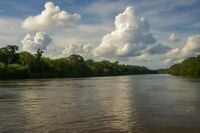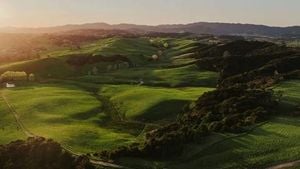In a remarkable convergence of scientific discovery and sustainable tourism, the Amazon basin has taken center stage in two headline-making stories this week. On one hand, paleontologists are celebrating the first-ever discovery of prehistoric insects preserved in amber in South America, offering a rare window into the Amazon’s distant past. On the other, CroisiEurope, a leader in river cruising, has announced plans to launch eco-friendly Amazon River cruises in 2027, promising travelers an immersive, responsible journey through one of the world’s most biodiverse regions. Together, these developments highlight both the ancient marvels and the enduring allure of the Amazon rainforest.
Scientists have long been mystified by the scarcity of ancient amber deposits in the southern hemisphere, particularly in the vast expanse that once made up the supercontinent Gondwana. According to The Associated Press, this mystery was upended when a team of researchers uncovered hundreds of amber fragments at the Genoveva quarry in Ecuador, perched on the edge of the modern Amazon basin. The amber, dating back 112 million years, contains exquisitely preserved beetles, flies, ants, and wasps—marking the first time such prehistoric insects have been found in South America.
“Amber pieces are little windows into the past,” said Ricardo Pérez-de la Fuente, a paleoentomologist at the Oxford University Museum of Natural History, who was not involved in the study. He explained that the discovery will help scientists understand the evolving relationships between flowering plants and insects during the age of dinosaurs. The study, published September 18, 2025, in Communications Earth and Environment, has already sent ripples through the paleontological community.
Fabiany Herrera, curator of fossil plants at the Field Museum in Chicago and co-author of the study, emphasized the significance of the find: “It was a different kind of forest,” Herrera noted, pointing out that the ancient Amazon was home to ferns, conifers, and the Monkey Puzzle Tree—species that no longer grow in the region. This snapshot of a vanished world suggests that the Amazon’s ecological tapestry has been in flux for millions of years, shaped by both evolutionary innovation and extinction.
The amber deposits themselves were not a complete surprise to everyone. Geologists and miners at the Genoveva quarry had long known of their existence, but it was Carlos Jaramillo of the Smithsonian Tropical Research Institute who, about a decade ago, set out to pinpoint their exact location. “I went there and realized this place is amazing,” Jaramillo recalled. “There’s so much amber in the mines,” he said, explaining that the open quarry made the deposits far more visible than they would have been beneath dense rainforest vegetation.
David Grimaldi, an entomologist at the American Museum of Natural History, called the lack of southern hemisphere amber “an enigma.” He was not involved in the discovery but noted that almost all known amber from the past 130 million years has been found in the Northern Hemisphere. The South American find, therefore, fills a crucial gap in our understanding of ancient ecosystems and the origins of the intricate partnerships between insects and flowering plants. “It’s the time when the relationship between flowering plants and insects got started,” Pérez-de la Fuente explained. “And that turned out to be one of the most successful partnerships in nature.”
While scientists are busy reconstructing the Amazon’s prehistoric past, a very different vision for its future is taking shape on the river’s winding waterways. CroisiEurope, a European river cruise giant, recently announced that it will launch its inaugural Amazon River cruises in 2027. As reported by Paramita Sarkar, these new voyages will be offered aboard the RV Brasilian Dream, a state-of-the-art, 32-guest vessel designed specifically for eco-conscious travelers.
The RV Brasilian Dream will embark on three exclusive 11-day itineraries, weaving through the rivers of Brazil, Colombia, and Peru. Each journey is carefully crafted to showcase the Amazon’s stunning natural diversity—from the dark, mysterious waters of the Rio Negro to the white-sand beaches of the Tapajós River. Guests will have the opportunity to observe wildlife, participate in cultural exchanges with indigenous communities, and explore protected natural reserves, all while enjoying the comforts of a luxury vessel.
What sets these cruises apart is CroisiEurope’s commitment to sustainability. The RV Brasilian Dream is equipped with low-carbon engines, solar panels, and onboard water treatment systems, ensuring that its environmental footprint is as light as possible. The ship’s design minimizes impact on the riverbed, and every aspect of the itinerary is intended to foster respectful, authentic interactions with local people and ecosystems. “Each itinerary emphasizes respectful interactions with indigenous communities, providing guests with authentic cultural experiences and supporting local economies,” the company stated.
Accommodations on the RV Brasilian Dream include 16 suites with private balconies—two of which are presidential suites—along with a gourmet restaurant serving Brazilian-inspired cuisine, a spa, fitness room, sun deck, and conference room. The ship’s intimate size and thoughtful amenities are meant to create a luxurious yet environmentally conscious experience for each guest.
According to CroisiEurope, these Amazon River cruises are more than just vacations; they are a chance to contribute to the conservation of one of the planet’s most vital ecosystems. With expert naturalists onboard and a focus on small group experiences, travelers will gain a deeper understanding of the Amazon’s fragile beauty and the challenges it faces in the modern era. The company’s approach reflects a growing trend in the travel industry toward sustainable, meaningful exploration—one that seeks not just to witness, but to preserve, the wonders of the natural world.
The juxtaposition of these two stories—one rooted in the deep past, the other looking boldly to the future—underscores the Amazon’s enduring significance. The same rainforest that once sheltered ancient beetles and conifers now beckons modern explorers, scientists, and travelers alike. The discoveries at the Genoveva quarry remind us that the Amazon’s story is far from complete; each new find adds another layer to our understanding of its evolution and resilience.
Meanwhile, initiatives like CroisiEurope’s sustainable cruises signal a hopeful path forward, one in which human curiosity and stewardship can go hand in hand. As the Amazon continues to reveal its secrets—both ancient and modern—the world is watching, eager to learn and determined to protect this irreplaceable treasure.




